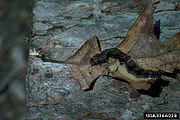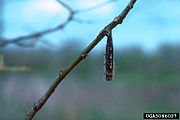
Nuclear Polyhedrosis Virus
Encyclopedia


Baculovirus
The baculoviruses are a family of large rod-shaped viruses that can be divided to two genera: nucleopolyhedroviruses and granuloviruses . While GVs contain only one nucleocapsid per envelope, NPVs contain either single or multiple nucleocapsids per envelope. The enveloped virions are further...
es is a virus
Virus
A virus is a small infectious agent that can replicate only inside the living cells of organisms. Viruses infect all types of organisms, from animals and plants to bacteria and archaea...
affecting insects, predominantly moths
Moths
Moths may refer to:* Gustav Moths , German rower* The Moths!, an English indie rock band* MOTHS, members of the Memorable Order of Tin Hats...
and butterflies. It has been used as a pesticide for crops infested by insects susceptible to contraction. Though commercialization of the viral pesticide is slow as the virus is very species specific, making it effective under certain circumstances.
The virus strain itself is protected in a polygonal structured capsid
Capsid
A capsid is the protein shell of a virus. It consists of several oligomeric structural subunits made of protein called protomers. The observable 3-dimensional morphological subunits, which may or may not correspond to individual proteins, are called capsomeres. The capsid encloses the genetic...
. This enables the virus
to infect cells more easily, and aids in reproduction of the virus. When the capsid is broken down within a host, virus strains are released and begin reproduction. Once there is a significant build up of virus, symptoms become noticeable.
Heliothis sp. is a cosmopolitan insect pest attacking at least 30 food and fibre yielding crop plants. They have been controlled by the application of NPV's Baculovirus heliothis. In 1975, Environmental Protection Agency, U.S.A. registered the B.heliothis preparations.
Related Science Fiction:
This virus is not dangerous to humans, but in the novel The Cobra Event
The Cobra Event
The Cobra Event is a 1998 thriller novel by Richard Preston describing a terror attempt on the United States by a lone man, the creator of a virus, called "Cobra", that mixes the incurable common cold with one of the world's most deadly diseases, smallpox...
by Richard Preston, the strain was altered with the Variola Minor virus (small pox) to create a highly contagious and lethal neurovirus called the ‘Cobra Virus’ – which affected humans as well as insects.
Symptoms
Symptoms are:- Discoloration (brown and yellow)
- Stress (regurgitationRegurgitation (digestion)Regurgitation is the expulsion of material from the mouth, pharynx, or esophagus, usually characterized by the presence of undigested food or blood.Regurgitation is used by a number of species to feed their young...
) - Decomposition (liquification)
- Lethargy (slow-moving to no movement at all. Refusal to eat)
The virus enters the nucleus of infected cells, and reproduces until the cell is assimilated by the virus and produces crystals in the fluids of the host. These crystals will transfer the virus from one host to another.
The host will become visibly swollen with fluid containing the virus and will eventually die - turning black with decay.
Transmissibility
The virus is unable to affect humans in the way it affects insects as our cells are acid-based, when it requires an alkaline-based cell in order to replicate.It is possible for the virus crystals to enter human cells, but not replicate to the point of illness.
It is transferred from insect to insect through crystals in all of their bodily emissions. As the virus is in the crystal-like capsid, it requires to be broken down by the alkaline digestive system of the insects to be released.
Mortality in infected insects is nearly 100%
Bleach and ultra-violet light have been found to prove effective in killing the virus.

